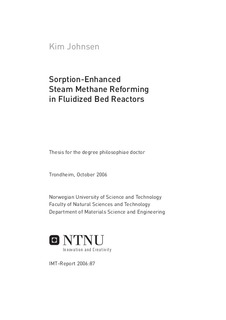| dc.description.abstract | Hydrogen is considered to be an important potential energy carrier; however, its advantages are unlikely to be realized unless efficient means can be found to produce it without generation of CO2. Sorption-enhanced steam methane reforming (SE-SMR) represent a novel, energy-efficient hydrogen production route with in situ CO2 capture, shifting the reforming and water gas shift reactions beyond their conventional thermodynamic limits.
The use of fluidized bed reactors for SE-SMR has been investigated. Arctic dolomite, a calcium-based natural sorbent, was chosen as the primary CO2-acceptor in this study due to high absorption capacity, relatively high reaction rate and low cost. An experimental investigation was conducted in a bubbling fluidized bed reactor of diameter 0.1 m, which was operated cyclically and batchwise, alternating between reforming/carbonation conditions and higher-temperature calcination conditions. Hydrogen concentrations of >98 mole% on a dry basis were reached at 600°C and 1 atm, for superficial gas velocities in the range of ~0.03-0.1 m/s. Multiple reforming-regeneration cycles showed that the hydrogen concentration remained at ~98 mole% after four cycles. The total production time was reduced with an increasing number of cycles due to loss of CO2 -uptake capacity of the dolomite, but the reaction rates of steam reforming and carbonation seemed to be unaffected for the conditions investigated.
A modified shrinking core model was applied for deriving carbonation kinetics of Arctic dolomite, using experimental data from a novel thermo gravimetric reactor. An apparent activation energy of 32.6 kJ/mole was found from parameter fitting, which is in good agreement with previous reported results. The derived rate expression was able to predict experimental conversion up to ~30% very well, whereas the prediction of higher conversion levels was poorer. However, the residence time of sorbent in a continuous reformer-calciner system is likely to be rather low, so that only a fraction of the sorbent is utilized, highlighting the importance of the carbonation model at lower conversions.
A dual fluidized bed reactor for the SE-SMR system was modeled by using a simple two-phase hydrodynamic model, the experimentally derived carbonation kinetics and literature values for the kinetics of steam reforming and water gas shift reactions. The model delineates important features of the process. Hydrogen concentrations of >98 mole% were predicted for temperatures ~600°C and a superficial gas velocity of 0.1 m/s. The reformer temperature should not be lower than 540°C or greater than 630°C for carbon capture efficiencies to exceed 90%. Operating at relatively high solid circulation rates to reduce the need for fresh sorbent, is predicted to give higher system efficiencies than for the case where fresh solid is added. This finding is attributed to the additional energy required to decompose both CaCO3 and MgCO3 in fresh dolomite. Moreover, adding fresh sorbent is likely to result in catalyst loss in the purge stream, requiring sorbents with lifetimes comparable to those of the catalyst.
Thermo gravimetric analysis (TGA) was used to study the reversible CO2-uptake of sorbents. In general, the multi-cycle capacity of the dolomite was found rather poor. Therefore, synthetic sorbents that maintain their capacities upon multiple reforming-calcination cycles were investigated. A low-temperature liquid phase co-precipitation method was used for synthesis of Li2ZrO3 and Na2ZrO3. Li2ZrO3 showed a superior multi-cycle capacity compared to Arctic dolomite in TGA, but the rate of reaction in diluted CO2 atmospheres was very slow. The synthesized Na2ZrO3 proved to have both fast carbonation kinetics and stable multi-cycle performance. However, regeneration in the presence of carbon dioxide was not easily accomplished.
The findings of this thesis suggest that the bubbling fluidized bed reactor is an attractive reactor configuration for SE-SMR. Low gas throughput is the major disadvantage for this configuration, and operation in the fast fluidization regime is most likely to be preferred on an industrial scale of the process. Future work should focus on developing sorbents and catalysts that are suited for high velocity operation, with respect to reactivity and mechanical strength. | nb_NO |

